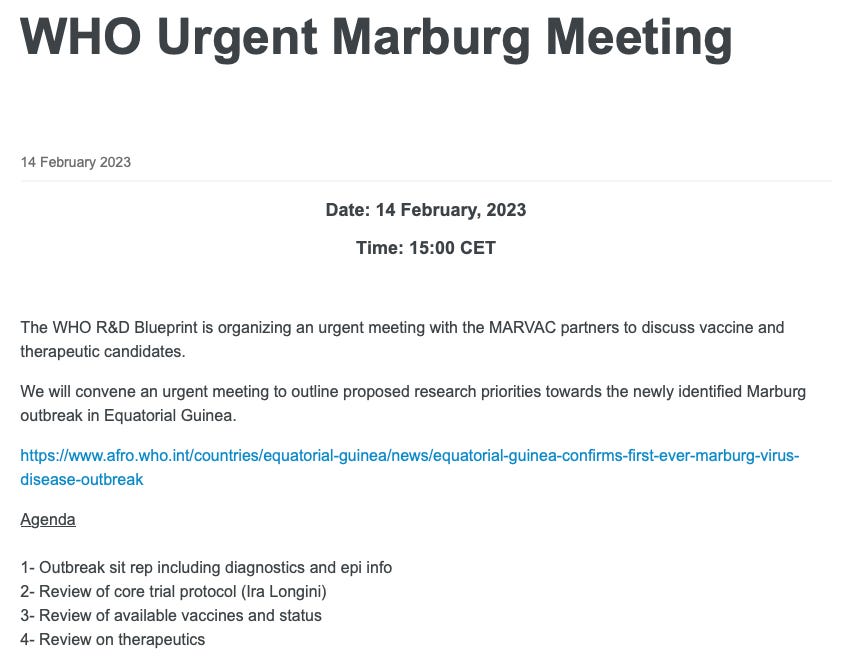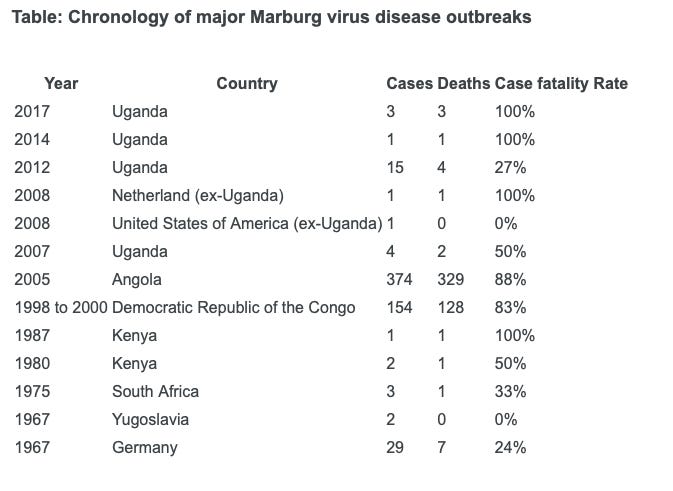Marburg Outbreak in Africa
The World Health Organization called for an urgent meeting to discuss the vaccine and therapeutic candidates for the newly identified Marburg virus outbreak in central Africa
The World Health Organization called for an urgent meeting to discuss the vaccine and therapeutic candidates for the newly identified Marburg virus outbreak in central Africa.
Yesterday the WHO confirmed the recently identified hemorrhagic fever cases in Equatorial Guinea as Marburg fever. While only one positive test has been reported, there are 16 suspected cases, with 9 deaths.
On August 2021, the WHO was notified of a confirmed case of Marburg virus (MARV) in Guinea which raised alarms about a possible outbreak. This led the WHO to call for the rapid development of MARV vaccines. Now they are ready to test the efficacy of the vaccine. Conveniently there is a current active outbreak.
In 2020, under the cover of all of the COVID-19 news, Department of Health and Human Services Secretary Alex Azar issued a new notice of declaration under the Public Readiness and Emergency Preparedness (PREP) Act to provide immunity for activities related to ‘countermeasures’ against Marburg virus and/or Marburg Disease. Just like the COVID-19 vaccines.
The NIH has already completed a Phase 1 human trial on 40 deathly adults given the investigational Marburg vaccine in 2022.
What is Marburg?
Marburg virus is a highly infectious and often fatal virus in humans belonging to the Filoviridae, which also includes the Ebola virus. Marburg disease is an extremely virulent illness that leads to hemorrhagic fever and has an approximate case fatality rate of 88%.
How is it transmitted?
Marburg can spread between humans in close environments and through direct contact. Humans can become infected with Marburg virus through contact with infected animals, such as bats and primates, or through direct contact with bodily fluids of infected individuals, such as blood, saliva, vomit, urine, and feces. Infection can also occur through contact with contaminated objects, such as needles and medical equipment. The virus can be transmitted between humans through close contact with blood, bodily fluids, or tissues of infected individuals.
Since the discovery of Marburg virus in 1967, there have been several outbreaks of Marburg virus disease reported in different parts of the world, mostly in Africa. According to the World Health Organization (WHO), there have been a total of 12 outbreaks of Marburg virus disease reported as of 2021. The outbreaks have been relatively small, with the largest one occurring in Angola in 2005, which resulted in 374 cases and 329 deaths.
What is particularly troubling about Marburg is the incubation period which ranges from 2 to 21 days, with the average being 5 to 10 days. During this period, an infected person may not have any symptoms, but they can still transmit the virus to others.
Be Informed but no need to worry. Marburg virus has the potential to cause outbreaks but the likelihood of a pandemic is extremely low.
If you find the content on this Substack valuable, please consider becoming a paying subscriber. Your support is greatly appreciated and allows me to continue providing this important information.





No comments:
Post a Comment